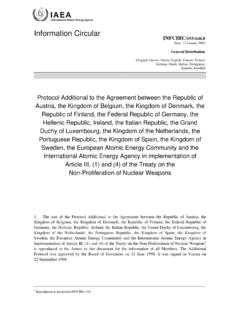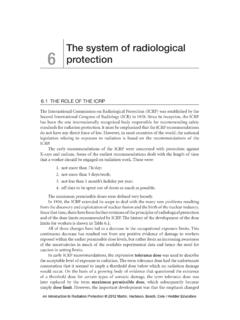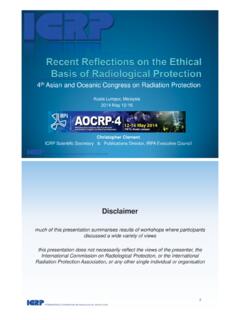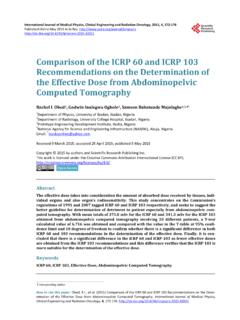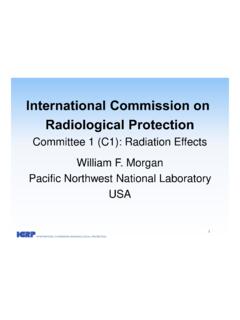Transcription of The International Commission on Radiological Protection ...
1 Topical reportThe International Commissionon Radiological Protection : historical overviewThe ICRP is revising its basic recommendationsby Dr H. SmithWithin a few weeks of Roentgen's discovery ofX-rays, the potential of the technique for diagnosingfractures became apparent, but acute adverse effects(such as hair loss, erythema, and dermatitis) madehospital personnel aware of the need to avoid over-exposure. Similar undesirable acute effects werereported shortly after the discovery of radium and itsmedical applications. Notwithstanding these observa-tions, Protection of staff exposed to X-rays and gammarays from radium was poorly British X-ray and Radium Protection Committeeand the American Roentgen Ray Society proposedgeneral radiation Protection recommendations in theearly 1920s. In 1925, at the First International Congressof Radiology, the need for quantifying exposure wasrecognized.
2 As a result, in 1928 the roentgen wasadopted by the International Committee on X-ray andRadium Protection as a measure of exposure to X- andgamma-rays-The recommendation on exposure limits graduallyevolved over the next decade and, by 1937, it wasconsidered that a healthy person could tolerate occupa-tional exposure to X- or gamma rays up to roentgenper working day without developing skin damage,anaemia, or incurring impaired fertility. At the time ofthe Sixth International Congress on Radiology in 1950,the International Commission on Radiological Protec-tion (ICRP) and its sister body, the InternationalCommission on Radiological Units (ICRU) were formedfrom previous committees. Each Commission consistedof 12 members and a chairman. To cope with theconsiderable expansion in work with radiation sourcesand radioactive materials, the ICRP set up five subcom-mittees.
3 The first recommendations of ICRP were pub-lished in 1951. The Commission reiterated its previouslyheld view that the adverse effects of exposure to: radia-tion included skin damage, cataracts, anaemia, andimpaired fertility. In addition, malignant diseases in theirradiated person's children were included. Therecommended permissible dose rate at this time roentgen per working week for penetrating X- andDr Smith is Scientific Secretary, International Commission on Radio-logical rays; roentgen per working week for radia-tion, affecting only superficial tissues; and roentgenper working week for in the 1950sBy then, it was accepted that the roentgen wasinappropriate as a measure of exposure. In 1953, theICRU recommended that limits of exposure should bebased on consideration of the energy absorbed in tissuesand introduced the rad (radiation absorbed dose) as aunit of absorbed dose (that is, energy imparted by radia-tion to a unit mass of tissue).
4 In 1954, the ICRP introduced the rem (roentgen equivalent man) as a unitof absorbed dose weighted for the way different types ofradiation distribute energy in tissue (called the doseequivalent in 1966). The weekly recommended doselimits for X- and gamma rays to critical organs (a recog-nition of variable tissue radiosensitivity), still expressedin roentgen but abbreviated to R, were R for skinand R for blood-forming organs, gonads, and lens ofthe eye (with less restrictive limits for radiation with lowpenetration into tissues). The 1959 recommendationsreflect an increasing understanding of the biologic basisof radiation-induced tissue damage. They included anage-related formula for workers above 18 years of ageto calculate the maximum permissible dose (MPD) to thegonads, blood-forming organs, and the lens of the eyes;a weekly maximum dose of rem to be used forplanning and design purposes; a recognition thatexposure was not necessarily at a constant rate but thata person's occupational exposure should not exceed3 rem during any period of 13 consecutive weeks; fornon-radiation workers the annual dose should not rem for the critical organs.
5 And a setting of remas an annual dose limit for members of the in the use of these dose limits was that noappreciable bodily injury would occur from radiationduring the lifetime of the individual even though thatperson might be exposed at the limit for tens of in the 1960sRevised recommendations in 1964 included the use ofa quality factor (QF), which is dependent only on theIAEA BULLETIN, 3/1988linear energy transfer (LET) of the radiation rather thanrelative biologic effectiveness (RBE), which is a ratio ofabsorbed doses of different radiations producing thesame biologic end-point. They also included the recogni-tion of increased radiosensitivity of the foetus, byrecommending that women of reproductive age, shouldnot be exposed while at work to more than rem ina 13-week period and that all lower abdominal radio-logic examinations that were not' essential should belimited to the 10 days following the onset of menstrua-tion, when pregnancy is 1966 recommendations established the need toprevent the acute effects of radiation and to limit the riskof cancer and genetic abnormalities in the offspring ofirradiated parents to an acceptable level.
6 Implicit in thisrecommendation is the acceptance of a linear dose-response relationship for cancer and genetic abnormali-ties without a threshold dose but with a dose-rate now, the MPD expressed on an annual basis(quarterly doses from the total intake of radioactivematerials were restricted to half the MPD) were 5 remfor uniform whole-body irradiation or the irradiaton ofthe gonads and red bone marrow these being the mostradiosensitive tissues; 30 rem to skin, thyroid, and bone;75 rem to the extremities; and 15 rem to all otherorgans. Annual dose limits for members of the publicwere one-tenth of the workers Commission structure had by now become wellestablished and committees were created on radiationeffects, internal exposure (now secondary standards),external exposure (now Protection in medicine), andapplication of the Commission 's , objectives in the 1970sNumerous reports were issued between 1959 and1977 relating to the scientific basis of radiation protec-tion, monitoring for incorporated radionuclides, and theapplication of recommendations.
7 However, the basicrecommendations were not revised until 1977 reflectingthe evolution of ideas expressed in early reports. In thereport, it was considered necessary to limit the incidenceof radiation-induced fatal cancers and serious geneticdisorders in the offspring (so-called stochastic effectsthat have a statistical dose-related probability ofoccurring at any level of radiation) to a level acceptedby society. This level should be at least comparable, inthe case of workers, to the incidence observed inindustries having high standards of safety, and toprevent other harmful effects (so-called non-stochasticeffects, the severity of which increases with dose and forwhich there is a threshold dose below which the effectscan be avoided). These objectives could be achieved if: no practice was adopted, unless it produced a netpositive benefit; exposures were as low as reasonably achievable,ecdnomic and social factors being taken into account;and the dose equivalent to individuals did not exceed therecommended limits for particular circumstancesdefined by the determining an estimate of the stochastic risks,derived from reviews by the United Nations ScientificCommittee on the Effects of Atomic Radiation(UNSCEAR) and the.
8 Biological Effects of IonisingRadiations Committee (BEIR) of the US NationalAcademy of Sciences, it was assumed that eachorgan or tissue contributed a certain fraction of thetotal risk (estimated to be x 10"4 per rem, x 10~2Sv~' in the SI system of units, followingirradiaton of the whole body). The effective doseequivalent weighted for susceptibility to the harming ofdifferent tissues (as defined in a subsequent statement in1978) was used to estimate the contribution of the organor tissue dose to the whole-body equivalent a radiation worker, the limit on annual effectivedose equivalent for uniform irradiation was 5 rem(50 millisievert). For individual members of the public,a limit of rem ( ), as applied to criticalgroups, was considered to provide an adequate degree ofsafety, in that the application of this limit was likely toresult in average annual effective dose equivalents ofless than rem ( millisievert).
9 Current developmentsThe Commission is presently revising its basicrecommendations which were presented in 1977 and ina number of subsequent statements and amendments aswell as in other ICRP objective of the revision is to review and updatethese policy statements for consistency and to produce asingle set of basic recommendations, presented asclearly and unambiguously as possible, supported byexplanations and references to current scientific infor-mation. The revised recommendations are expected tobe completed by 1990 after preparatory work by theCommission's committees and a number of ad hoc taskgroups. This work includes review and reassessment ofthe complete system of dose limitation, including thevalues of the dose this connection, current work on assessing thecancer risk is being carried out, for example, byUNSCEAR and by the BEIR committee, as well as bythe Commission 's committee on biological effects.
10 Theresults of several studies are expected to be available inless than two the risk data on cancer and inherited disordersare yet far from conclusive, the Commission will awaitthe result of the comprehensive evaluations of its sourcesof epidemiological information that are currently beingmade, before judging the consequences for the revisionof its system of dose limitation. In the meantime, it willbe prudent to follow the present recommendations ondose limitation as they were intended to be this is done, the value of the dose limits, in mostcases, will not be the controlling factor in the restrictionof doses; therefore, the final judgement on the choice ofdose limits can await full scientific review without anyserious consequences. A review is also in preparation onthe effect of the new dosimetry on the estimate of risksof severe mental retardation being caused by exposure ofchildren to radiation during their development in BULLETIN, 3/198843 This effect might be caused during the period of8-15 weeks after fertilization, and, with less sensivity,from 16-25 weeks after fertilization, but without detect-able sensitivity for induction of these effects at otherperiods of pregnancy.

